Wine of the future?
More than a fifth of all the vineyards in Alsace are planted to Pinot Blanc. But, in the hierarchy of Alsatian grape varieties, Pinot Blanc takes a humble position. Most Pinot Blanc is used for the production of Crémant. When did you last drink a still Alsatian Pinot Blanc? We set out to explore this high-potential variety.
Say Alsace, and Riesling and Gewürztraminer are probably the first things that spring to mind. Riesling, with around 20 percent of the vineyard surface in what are generally considered the best locations, has certainly become the region’s signature grape variety. With its rich, tropical aromas and flavors, Gewürztraminer adds an utterly unique and distinctive touch to the region’s profile. And with 19 percent of the vineyard area, it is big too.
Less well-known are Muscat and Pinot Gris, but, alongside Riesling and Gewürztraminer, the two belong to the four so-called ‘noble’ varieties, the holy tetrad of Alsatian winemaking. Despite their status as ‘noble grapes’, Muscat’s, Pinot Gris’s and Gewürztraminer’s fame is less widespread. Oliver Humbrecht of Domaine Zind-Humbrecht in Turckheim even speaks of specialty wines. Meanwhile, the importance of Pinot Noir is increasing – it now accounts for 12 percent of all the vineyards. On the sidelines of these five, there is a sprinkling of Sylvaner, Chasselas, and Chardonnay. And just as in Baden, Alsace’s German neighbor, Syrah is starting to make inroads.
And then there is Pinot Blanc – with 22 percent of the vineyard area or more than 3300 hectares, this ‘unnoble’ grape is Alsace’s most important. Truth be told, vineyard statistics don’t distinguish between Pinot Blanc and Auxerrois. Just like Chardonnay, Auxerrois is a cross of Pinot and Gouais Blanc, making Auxerrois a child of Pinot and a sibling of Chardonnay. Although, as Olivier Humbrecht explains, Auxerrois is slightly more aromatic and a bit less acidic, in the Alsatian mind, the two are so similar, they are often perceived as one and the same. In the cellar they perfectly complement each other. Oddly enough, wines can be labeled as Pinot Blanc with any percentage of Auxerrois blended in. But the other way around, a wine can only be labeled as Auxerrois when it is made of 100 percent Auxerrois. There are just a limited number of producers that make a pure, 100 percent Pinot Blanc.
Alsace ©Domaine Josmeyer
Alsace is a wine region that has historically been defined by its varieties. For some, the relatively wide range of varieties makes it difficult to market the region. On top of that, it used to be hard for consumers to understand the sweetness level of the wines. Traditionally, wines could be off-dry without it being stated on the label. Although labeling requirements have improved, and Riesling has established itself as the main high-quality variety for top dry wines, sales of Alsatian wines are in a slump.
“Fortunately, last year the overall sales stabilized,” Margaux Bruckert of the Comité Interprofessionel des Vins d’Alsace tells me. However, there was only one category that showed significant growth: Crémant d’Alsace. And what is the foundation of Crémant’s base wine? Correct – Pinot Blanc. The variety has good acidity and a relatively neutral flavor profile, making it a perfect grape for a traditional-method sparkling wine.
But why not tap into its potential as a variety for beautiful dry still wines?
“It isn’t that simple,” Humbrecht explains. “For Crémant we need a high-yielding, neutral clonal variety. That is what has been planted, mainly in the more fertile, flatter vineyards on the Rhine Valley floor. These clonal varieties are less feasible for still white wines.” For Crémant you typically need the purest juice, free run and from the first pressing. The press yield for sparkling wine is usually around 50 to 55 percent. So, why wouldn’t you use the remaining juice for a somewhat structured still wine? “The grapes for Crémant,” Humbrecht continues, “are harvested early when the acidity is still relatively high and the sugar low. Even if the quality of the second pressing would have ripe-enough tannins, the potential alcohol would be too low for a still wine.”
Meyer-Fonné Pinot Blanc ©Meyer-Fonné
Felix Meyer from Domaine Meyer-Fonné in Katzenthal also emphasizes the importance of good clones. “Nowadays,” he says, “it is hard to find Pinot Blanc fin, vines that grow small bunches with small berries containing concentrated juice.” No wonder he treasures his plots with old vines.
Nonetheless, there are believers in still Alsatian Pinot Blancs. Vincent Fleith of the eponymous winery loves the variety. He calls Pinot Blanc “un vin d’avenir” – a wine of the future. “First of all, Pinot Blanc is well-adapted to rising summer temperatures. Furthermore, the variety is suitable for many different styles: monovarietal, blended and as a crémant. The vine gives a reliable yield, and the wines are easy to drink, have subtlety and are less prone to excessive sugar build-up than Pinot Gris. And finally, they pair well with food, in particular quiche and hors d’oeuvres.” Everyone praises Pinot Blanc’s versatility. “In the end, Pinot Blanc is always the winner,” says Catherine Faller of Domaine Weinbach. Her Pinot Blanc certainly is. And the pairing with her homemade creamy tarte d’oignon was heavenly.
Domaine Weinbach ©Domaine Weinbach
Fruité, botrytised, natural or blended
Most of the Alsatian Pinot Blancs are fruité and have high drinkability. Zind-Humbrecht’s and Weinbach’s Pinot Blancs are outstanding examples. Pierre Gassmann of Rolly-Gassmann in Rohrschwir takes another approach. For him, botrytis lies at the core of the identity of Alsatian wines. He also emphasizes the importance of prolonged time in bottle. If needed, he postpones the release of his wines for years. As a result, his cellar houses no less than two million bottles. His Pinot Blancs – I tasted the vintages 2021, 2015 and 2003 – normally have some residual sugar and typically show complex aromas and flavors associated with the botrytised grapes, the intensity of which depends on the vintage. (For further notes, see below.)
Wineries like Domaine Marc Kreydenweiss in Andlau and Pierre Frick in Pfaffenheim lean more towards a low-intervention style of winemaking, the first less so than the second. Nonetheless, their expressions are very different. While Frick’s wines can have an earthy tone, Kreydenweiss’s Pinot Blancs are extremely linear.
Felix Meyer of Domaine Meyer-Fonné may well be the king of blending Pinot Blanc with other varieties. He divides Alsace’s varieties in two groups: the Rheinland (Riesling, Gewürztraminer and Sylvaner) and the Burgundian varieties (Pinot Gris, Pinot Blanc, Pinot Noir, Chardonnay). Meyer’s claim is that the Rheinland varieties are focused on fruit expression and could be drunk young. The Burgundian varieties need long ageing. Genetically, he says, Pinot Gris and Pinot Blanc are closer related than Pinot Blanc and Auxerrois, the most common blending partner of Pinot Blanc in Alsace. So why not blend Pinot Blanc with Pinot Gris? His mouthwatering Pinot Blanc Vieilles Vignes is actually a blend of Auxerrois, Pinot Blanc, Pinot Gris and a tiny bit of Chardonnay, the ratio depending on the vintage. Climate change makes blending even more compelling, according to Meyer.
The Meyer-Fonné family ©Meyer-Fonné
No Grand Cru
Not being one of the noble varieties means Pinot Blanc from Grand Cru vineyards cannot be labeled as such, making it less interesting to plant. It explains why Pinot Blanc does not always seem to be taken seriously. “When the Alsatians started preparations for the introduction of the Grand Cru designation in the early 1970s, the Burgundians claimed the use of the term,” Remy Gresser of Domaine Gresser in Andlau explains. “If we wanted to use the Grand Cru designation, we should delimit the vineyard areas and define the permitted varieties per Grand Cru. The Burgundians effectively stopped us from using Burgundian varieties (the Pinots and Chardonnay) in our Grands Crus. That is why Pinot Blanc never became a noble variety. As Pinot Gris was known as Tokay in Alsace in those days, it could escape the Burgundian scrutiny.” It put a brake on the spread of the variety as a source of top still, dry white wine. But as Humbrecht tells me, Pinot Blanc will certainly be among the varieties that will be permitted in some of the vineyards that are designated for Premier Cru status. Which vineyards that will be, Humbrecht can’t tell. If the long-in-the-making Premier Cru designation will finally materialize remains unclear as well. But Humbrecht is hopeful and claims there is momentum. So, if the stars align, we may see more Alsatian still, dry Pinot Blanc in the future.
ALSATIAN PINOT BLANCS from VISITED WINERIES
Domaine Weinbach
Grapes are from Clos des Capucins, the vineyard that surrounds the winery, plus 10 percent from de Grand Cru Schlossberg.
Fermentation and maturation (appr. 1 year on the fine lees) in old traditional Alsatian foudres.
Pinot Blanc 2023: Dry, ripe yellow fruit, round acidity, subtle flavors and aromas of white flowers, apple, hay, almond melon.
Pinot Blanc 2017: Just started to develop tertiary flavors: umami-ish reminiscent of lychee or other tropical fruit, seemed to have a bit more structure than 2023.
Pinot Blanc 2010: Development of tertiary had clearly set in. Umami pineapple, still very fresh, remarkable but not overbearing concentration.
Pinot Blanc 2002: Soft creamy touch, some saffron, a hint of white truffle, some licorice, on top of some remaining fresh primary fruit touches.
Pinot Blanc 1996: Savory, white truffle flavor, a streak of tomato paste, clean and pure, vaguely some strawberry and a hint of toasted bread, acidity still provides lift.
Domaine Zind-Humbrecht
Pinot Blanc 2023: Wet stones, perfect balance between fruit ripeness and acidity, dry, lemony, long.
Domaine Meyer-Fonné
Blend of Auxerrois (appr. 45 percent), Pinot Blanc (35 percent), Pinot Gris (15 percent), Chardonnay (5 percent), ratio may vary depending on vintage.
One year on the fine lees in old foudres.
Pinot Blanc Vieilles Vignes 2023: Stony, slightly smoky, some blossomy white flower, hay, hint of licorice, yellow apple, later followed by ripe pear. Beautiful concentration, attractively medium-bodied. Overall harmonious and well balanced.
Pinot Blanc Vieilles Vignes 2022: Although the 2022 growing season was generally warm and dry, the soils contained more water. As a result, the Pinot Blanc from 2022 was a bit richer, riper and fruitier than the 2023 vintage.
Pinot Blanc Vieilles Vignes 2021: Due to the cool weather, this vintage contains a bit more Pinot Gris. Overall fresher with brighter fruit than 2022 and 2023.
Domaine Josmeyer
Pinot Blanc ‘Mise du Printemps’ 2023
Elegant, stony, smoky, lightly floral, subtle nose. Round, citrusy acidity.
Vincent Fleith
Pinot Blanc 2023
Vines cultivated biodynamically for 25 years. Slow pressing without maceration. Aged on fine lees for 12 months. Zero input. Sulphite adjustment at bottling.
Very reductive nose. Vincent Fleith said this vintage would not be released later this year. He expected the reductive notes to disappear within 8 to 12 months. Good concentration, structured, ripe white berry fruit, floral.
Domaine Kuentz-Bas
Pinot Blanc 2020:
Current vintage. 100 percent Pinot Blanc from relatively high vineyards in Husseren-les-Châteaux slowing down the ripening of the grapes.
Dry. Quite broad and ripe. Some floral notes, lightly smoky/minerally. Fresh acidity paired with round, yellow fruit concentration. Very good value for money.
Domaine Rolly-Gassmann
Pinot Blanc 2021:
80 percent Pinot Blanc, 20 percent Auxerrois. 20 percent botrytised grapes. 10 months on the fine lees in old foudres.
Off dry, but fine balance between residual sugar and medium acidity. Rich but not overwhelming flavor profile with hints of marmalade. Slightly bitter on the finish.
Pinot Blanc 2015:
60 percent botrytised grapes, also subjected to passerillage (on the vine).
Intense flavors, including honey, wax, acacia, marmalade.
Pinot Blanc 2003:
Due to the famously hot vintage with a lot of wind, the grapes had dried out more and developed a thicker than normal skin. Late harvest.
Mostly tertiary, but still good amounts of primary ripe fruit. Hint of volatile acidity. Again, aromas and flavors honey, wax, acacia and marmalade, but also peach and tropical notes. Vaguely some creamy and caramelly notes. Bit textural.
Domaine Marc Kreydenweiss
50 percent Pinot Blanc, 50 percent Auxerrois. Kreydenweiss mentions the lieu-dit (for example Kritt) instead of the variety on the label. Whole bunch pressing, juice settles in stainless steel, racked off into foudres, spontaneous fermentation (occasionally pied de cuve), at least 1 years on the fines lees, lightly filtered and a tiny bit of sulphite added at bottling.
Kritt 2022:
Dry. Austere. Relatively high fresh lemony acidity. Salty/minerally. Tiny hint of bitterness on the finish.
Kritt 2023:
Younger, slightly fruiter and fuller version. Leesy.
La Fontaine aux Enfants 2021:
50 percent Pinot Blanc, 50 percent Auxerrois. Same winemaking as the Kritt, but 26 months on the fine lees. La Fontaine aux Enfants is a plot on the back side of the Grand Cru Kastelberg and a potential candidate for Premier Cru status.
A tiny bit of butter on the nose, rounder than the Kritt on the palate. Nonetheless a linear expression of Pinot Blanc. Austere and lean.
Domaine Gresser
Les Graves 2022:
100 percent Pinot Blanc. Gravel and pebbles.
Flinty, clean, fruit driven, blanched almond, an agreeable hint of bitterness, tiny bit of oily roundness. Uncomplicated wine, good aperitif.
Les Graves 2023:
100 percent Pinot Blanc. Gravel and pebbles.
Similar profile as the 2022 vintage, with slightly less intensity, but more balance and ripeness.
Saint André 2023:
90 percent Pinot Blanc, 10 percent Auxerrois. Schist soils.
Fresh air-dried laundry, mineral, yellow apple, mineral
Saint André 2020:
40 percent Pinot Blanc, 60 percent Auxerrois. Schist soils.
More depth and fruit than the 2023 vintage, dry with possibly a tad residual sugar. Felt a bit shorter than the 2023.
Saint André 2010: umami, tomato paste, some ripe lemon, bit texture.
Pierre Frick
Pierre Frick may well be considered the king of natural wine in Alsace. His wines are made without added sulphite since the early 2000s.
Barrel sample Pinot Blanc/Auxerrois 2024: Apple, clean and lean, a bit smoky, only 11,6% abv.
Barrel sample Pinot Blanc 2024: Fresh, flinty, linear.
Pinot Blanc 2000:
Still made with a small amount of added sulphite. 3 to 4 g/l residual sugar, 14,5% abv.
Powerful. Honey, savory, hint of celery. Fascinating to see how Frick’s style has developed.
-+-+-+-+-+-
CATHERINE FALLER’S CULINARY RECOMMENDATION
Truffle Sandwich with Pinot Blanc
Ingredients:
– Two slices of pain de campagne, evenly sliced
– Soft salted butter, taken out of the fridge several hours before using.
– Black truffle, thinly sliced with a mandolin
Steps:
– Butter the slices of pain de campagne.
– Cover one slice of bread with black truffle.
– Close the sandwich and wrap in cling foil and aluminum foil.
– Leave the sandwich in the fridge for two days to allow the truffle to infuse the butter.
– Take the sandwich out of the fridge 5 hours before consumption.
– Grill the sandwich under a hot broiler for approximately 30 seconds each side but keep an eye on it.
Serve with Alsatian Pinot Blanc.
-+-+-+-+-+-
A version of this article has been published in DinVin Guide, issue 3, 2025.
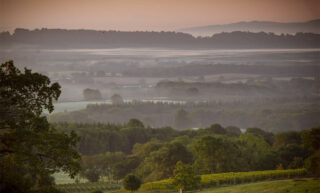
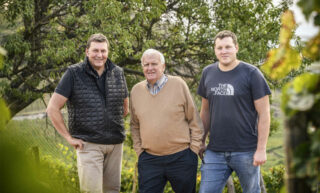
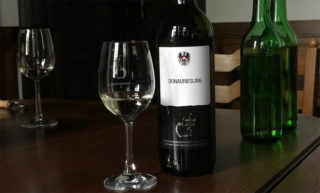
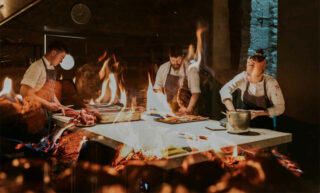
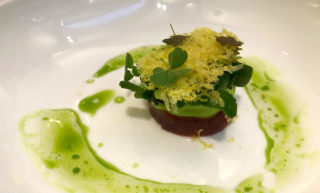
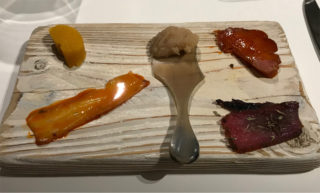
Comments